LED light therapy can help you diminish fine lines by stimulating your skin's natural collagen production. Using red light wavelengths between 630-700 nanometers, this treatment penetrates deep into your skin layers to boost cellular energy and trigger repair mechanisms. You'll need 6-12 sessions, each lasting 20-30 minutes, to see ideal results. While both professional and at-home devices work, consistency is key – aim for 3-4 weekly treatments. For enhanced benefits, combine your LED therapy with vitamin C or hyaluronic acid serums. The science behind this revolutionary treatment reveals why it's becoming a go-to solution for aging skin.
Understanding LED Light Therapy
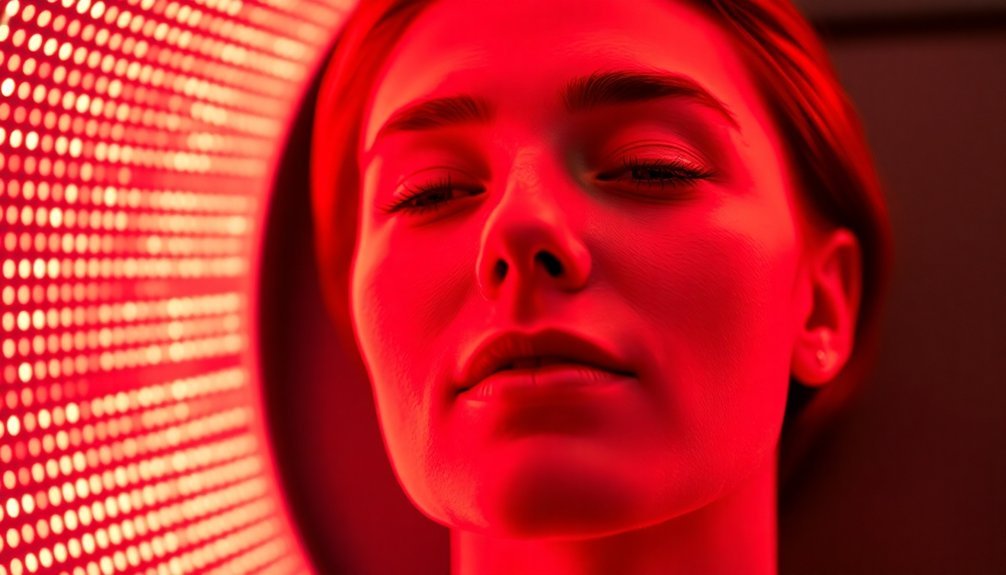
LED light therapy has emerged as a groundbreaking skincare treatment that harnesses the power of different light wavelengths to transform your skin. You'll discover that this non-invasive treatment uses specific light colors, including near-infrared, blue, red, and green light, each targeting distinct skin concerns to help you achieve your desired results.
Whether you're visiting a dermatologist's office or using an at-home LED device, you'll experience a gentle treatment that's completely painless. The procedure involves exposing your skin to carefully calibrated light frequencies that penetrate different skin layers. Clinical studies show that acne can be reduced by nearly 70 percent after completing a series of treatments.
During treatment, you'll wear protective eyewear while the LED lights work to stimulate cellular renewal and repair.
What makes LED light therapy particularly appealing is its versatility. You can combine it with other skincare treatments like facials, chemical peels, or microdermabrasion to enhance your results.
The treatment is customizable to your specific skin concerns, and you'll notice improvements even after your first session. Best of all, there's no downtime, so you can immediately return to your daily activities while your skin benefits from this innovative technology.
How Red Light Transforms Skin
Shining at a wavelength between 630-700 nanometers, red light therapy penetrates deep into your skin's layers to trigger remarkable cellular transformations. When the light reaches your cells, it stimulates ATP production, basically supercharging your skin's natural repair mechanisms.
This boost in cellular energy kicks off a chain reaction that increases collagen production, enhances blood circulation, and accelerates tissue healing.
Your skin undergoes three major changes during treatment:
- Your fibroblasts spring into action, producing fresh collagen and elastin that firm up your skin and smooth out wrinkles
- Your blood vessels expand and multiply through angiogenesis, delivering more oxygen and nutrients to skin cells
- Your cells' powerhouses (mitochondria) generate more ATP, energizing your skin's natural repair processes
Clinical studies back these transformations, with over 5,000 peer-reviewed papers confirming red light therapy's effectiveness. The therapy also helps control acne by targeting sebaceous glands and reducing excess oil production. You'll notice improvements in skin texture, tone, and firmness, while fine lines gradually fade.
The treatment's safety profile is excellent when used correctly, though you'll need to wear protective goggles during sessions. For ideal results, you can combine red light therapy with other treatments like microneedling.
Choosing Your LED Device
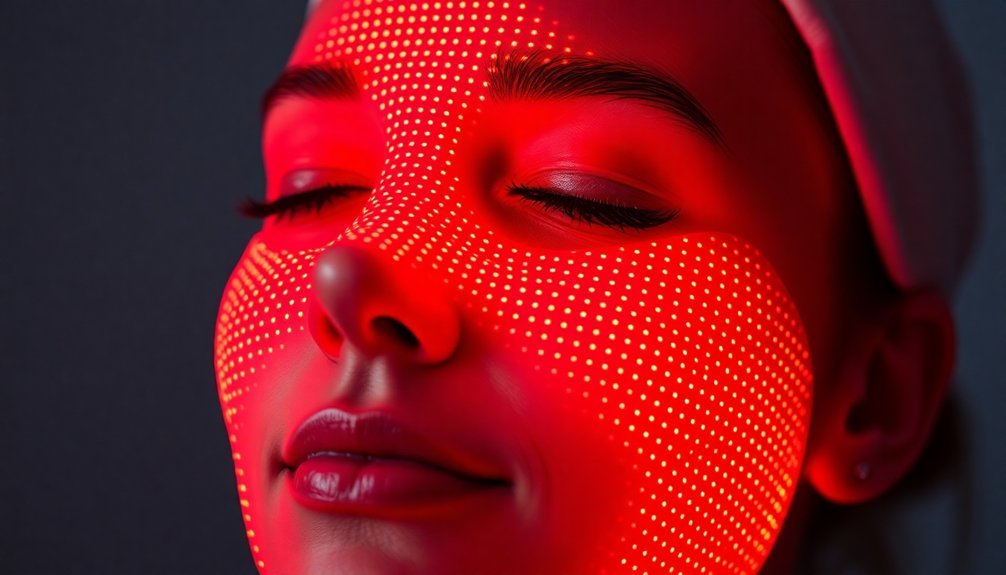
When choosing between professional and at-home LED devices, you'll notice considerable differences in power output, treatment coverage, and price points.
While professional devices offer stronger light intensity and faster results, FDA-cleared home devices can still provide significant benefits with consistent use. Expect to invest between $250 to $700 for a quality at-home device.
Your primary focus should be on safety certifications and clinical testing, ensuring your chosen device meets established standards for eye protection, automatic shut-offs, and recommended treatment durations.
Professional Vs Home Devices
Making an informed decision between professional and at-home LED devices can substantially impact your skincare results and budget.
Professional treatments deliver about 10 times more power than home devices, leading to faster, more noticeable improvements in skin texture, collagen production, and acne reduction. While these clinical sessions offer expert supervision and customized protocols, they're typically more expensive than home alternatives. Different wavelengths of light can penetrate skin layers to address specific concerns.
Home LED devices provide a cost-effective solution for long-term skincare maintenance. Though they require consistent use over several weeks to show results, they offer the convenience of fitting into your daily routine and the privacy of your own space.
Key differences between professional and home devices:
- Professional devices deliver immediate results due to higher intensity, while home devices require regular use for gradual improvement.
- Clinical treatments offer expert guidance and precise targeting of specific skin concerns, but come at a higher cost per session.
- Home devices allow for frequent use and flexibility in treatment schedules, though they operate at lower power levels.
Consider combining both approaches for the best results, using professional treatments for initial improvement and home devices for maintenance.
Safety Features Matter Most
Beyond all the impressive features LED devices may offer, safety components should be your primary consideration when selecting a device for home use. A safe LED device must include adequate eye protection, either through built-in shields or by providing protective goggles to prevent potential damage from direct light exposure.
When evaluating safety features, look for FDA-cleared devices that offer precise wavelength settings and consistent light coverage. You'll want to verify the device includes clear instructions and safety guidelines, particularly regarding treatment duration and frequency.
Don't overlook the importance of pre-treatment precautions, such as avoiding use on open wounds or conducting a patch test before full treatment.
Your chosen device should come with thorough safety protocols, including guidance on skin preparation and contraindications. It's vital to select a device that specifies when not to use it, such as during pregnancy or over skin growths.
The best LED devices combine multiple wavelengths while maintaining strict safety standards. If you experience any unusual reactions, don't hesitate to discontinue use and consult a healthcare provider. Remember, effective treatment isn't just about results—it's about achieving those results safely and responsibly.
Treatment Sessions and Protocols
The success of LED skin therapy hinges on following proper treatment protocols and scheduling sessions correctly. You'll need to commit to 6-12 sessions, each lasting 20-30 minutes, with appointments spaced 1-4 weeks apart depending on your specific skin concerns.
The good news is there's no downtime, so you can resume normal activities immediately after treatment.
Before each session, your skin must be thoroughly cleansed and exfoliated to remove buildup. Your provider will apply appropriate eye protection and a specialized serum before positioning the LED device about an inch from your face. Different wavelengths target specific concerns – red light for anti-aging and blue light for acne.
- Pre-treatment: Cleanse with a basic cleanser, exfoliate thoroughly, and verify your skin is free from makeup and oils.
- During treatment: Remain still while the device delivers light therapy for 15-30 minutes, or 5 minutes per zone with handheld devices.
- Post-treatment: Apply recommended serums (vitamin C or hyaluronic acid), moisturizer, and sunscreen for best results.
Maintenance sessions may be necessary to maintain your results, and you can enhance outcomes by combining LED therapy with other treatments like microcurrent therapy.
Science Behind Collagen Production
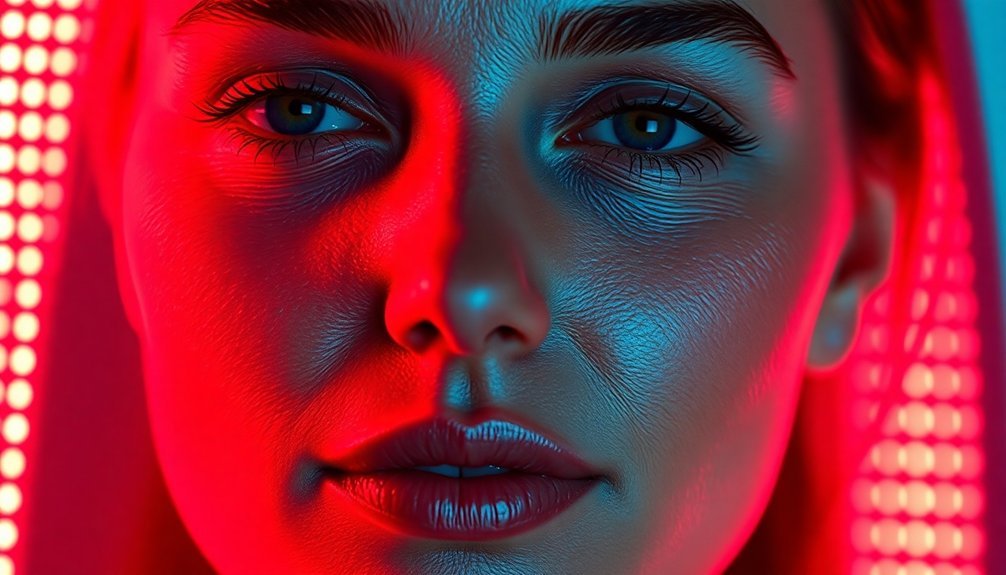
Scientific research reveals how LED light therapy triggers a remarkable chain of biological responses in your skin cells to boost collagen production. When specific wavelengths of light penetrate your skin, they stimulate fibroblasts, the cells responsible for producing collagen and elastin. This process activates ATP production, which serves as cellular fuel for various regenerative processes.
| Light Color | Wavelength Effect | Primary Benefits |
|---|---|---|
| Red | Penetrates Deeply | Stimulates Fibroblasts & ATP |
| Near-Infrared | Maximum Penetration | Enhanced Collagen Synthesis |
| Amber | Surface Level | Improves Lymphatic Flow |
| Blue | Shallow Penetration | Controls Bacteria Growth |
Your skin's natural collagen production begins declining in your mid-20s, but LED therapy can help counteract this process. The red and near-infrared wavelengths prove most effective, with studies showing that 97.4% of users experience visible improvements in skin tone and wrinkle reduction. The therapy works by transferring light energy to your skin cells, triggering cytokine production and enhancing cellular communication. It's a non-invasive approach that doesn't cause burns or pain, making it safe for regular use in your skincare routine.
Red Light Versus Other Treatments
When you're comparing treatment options, red light therapy stands out for its ability to penetrate deeper into your skin layers than most topical treatments, making it particularly effective for collagen stimulation and skin rejuvenation.
You'll typically see initial improvements within 4-6 weeks of consistent red light therapy sessions, with the most dramatic results appearing after 84 days of treatment, showing up to 38.3% reduction in visible signs of aging.
While topical treatments may offer quick but temporary results, your investment in red light therapy can lead to longer-lasting improvements, especially when you maintain a regular treatment schedule of 3-4 weekly sessions.
Red Light's Deep Impact
Red light therapy stands out among skin treatments by penetrating deep beneath the surface, where it sparks significant cellular changes. When the red light reaches your skin's deeper layers, it stimulates the production of adenosine triphosphate, your cells' primary energy source. This boost in cellular energy accelerates repair and regeneration, while simultaneously promoting collagen production and enhancing your skin's elasticity.
You'll notice several key benefits as the red light penetrates your skin's layers:
- Deep tissue stimulation that triggers fibroblast production and increases blood flow, leading to enhanced skin texture and tone
- Cellular regeneration that helps reduce inflammation and promotes the formation of new blood vessels
- Increased collagen synthesis that naturally diminishes fine lines and wrinkles without recovery time
What makes red light therapy particularly effective is its versatility. You can use it alone or combine it with other treatments like blue light therapy for enhanced results.
It's also FDA-cleared for home use, making it a convenient option for your skincare routine. The therapy's deep-reaching properties make it especially effective for addressing both surface-level concerns and deeper skin issues simultaneously.
Treatment Time And Results
A successful journey with LED skin therapy depends heavily on your commitment to consistent treatment sessions. You'll need to dedicate 10-30 minutes, 2-3 times per week, to achieve ideal results. While this might seem like a significant time investment, it's comparable to other skincare routines but with more scientifically proven benefits.
You can expect to see noticeable improvements within 1-3 months of regular use, particularly in skin texture and elasticity. The therapy stimulates your body's natural collagen and elastin production, leading to reduced fine lines and wrinkles that can last up to six months after completing treatment.
| Treatment Aspect | Red Light LED | Traditional Methods |
|---|---|---|
| Session Length | 10-30 minutes | 30-60 minutes |
| Recovery Time | None needed | Days to weeks |
| Side Effects | Minimal to none | Varying severity |
Clinical studies confirm that red light therapy's effectiveness matches or exceeds many traditional skin treatments. You'll achieve the best results by maintaining a consistent schedule and potentially combining LED therapy with complementary treatments like microneedling. Remember, just like exercise, the benefits are cumulative – the more regularly you treat, the better your results will be.
Professional LED Treatment Options
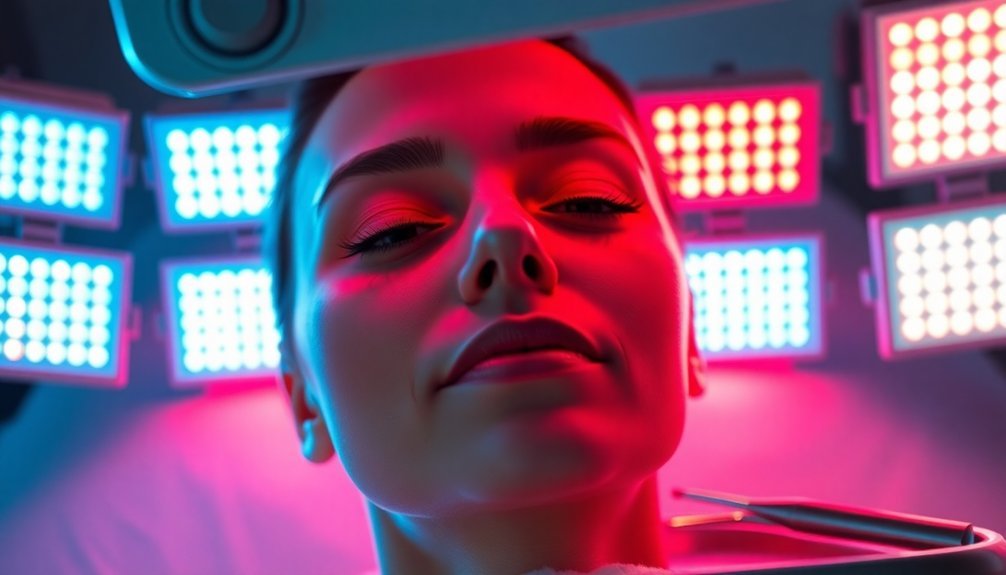
Thanks to advances in skincare technology, professional LED light therapy now offers a diverse range of treatment options for both skin and hair concerns.
You'll find customizable treatments that combine different light wavelengths to target specific issues, from acne reduction to collagen stimulation. These professional services often integrate LED therapy with other proven treatments like PRP and medical facials for enhanced results.
When you visit a skincare professional, you'll have access to FDA-cleared devices that deliver precise wavelengths of red, blue, orange, and white light. These professional-grade machines offer more powerful and targeted treatment than at-home devices, delivering ideal results for your specific skin concerns.
- Multi-wave LED treatments that combine different light colors to address multiple skin issues simultaneously
- Customized LED facial treatments that adapt to your skin's unique needs and concerns
- Advanced combination therapies that integrate LED light with microdermabrasion or exfoliation for thorough skin rejuvenation
Professional LED treatments are particularly effective for stimulating collagen production, reducing inflammation, fighting acne-causing bacteria, and promoting hair growth.
Your esthetician can create a tailored treatment plan using various light wavelengths to achieve your desired results.
Daily LED Therapy Routine
Establishing an effective LED therapy routine requires careful attention to timing and preparation. You'll need to cleanse your face thoroughly and guarantee your skin is completely dry before beginning treatment. Remove all makeup and sunscreen, as these can block the light's effectiveness.
For anti-aging benefits, use red light therapy 3-5 times weekly, ideally at night when your body's natural regeneration processes are most active.
If you're targeting acne, use blue light therapy in the morning, as it won't interfere with your sleep patterns and can be used daily for persistent breakouts. The general recommendation is 10-minute sessions, four times per week.
After your LED session, follow with your regular skincare routine. Apply toner, serums, and moisturizer in that order. You can enhance results by combining LED therapy with complementary skincare products.
For maximum progress tracking, take photos before starting your treatment regimen. Remember, consistency matters more than frequency – it's better to maintain a regular schedule of 3-4 weekly sessions than to use the device sporadically.
Your LED device is UV-free and non-heating, making it safe for regular use.
Real Results and Clinical Studies
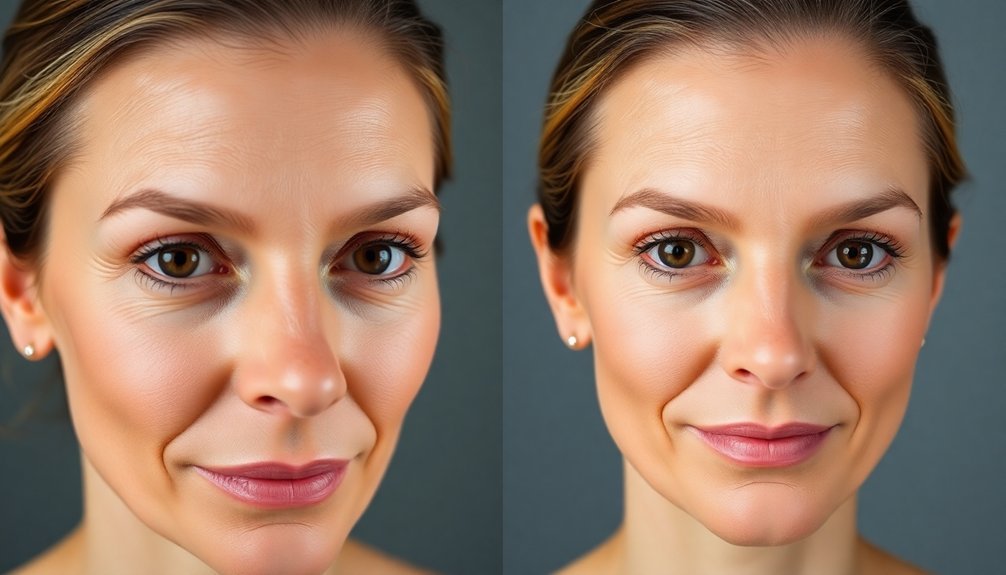
Countless clinical studies have validated the effectiveness of LED light therapy for skin rejuvenation and anti-aging benefits. Systematic reviews and meta-analyses confirm that red light therapy, particularly at 660 nm, substantially improves the appearance of fine lines and wrinkles.
You'll find that combining red and blue light treatments delivers even more extensive results, targeting both aging concerns and skin inflammation.
Clinical trials consistently demonstrate impressive outcomes, with participants reporting high satisfaction rates and noticeable improvements in skin texture and tone. The science behind these results is clear: LED therapy penetrates deep into your skin, stimulating collagen production and activating fibroblasts – the cells responsible for skin recovery and rejuvenation.
Here's what clinical studies have revealed about LED therapy results:
- Red light therapy stimulates natural collagen production, leading to measurable reductions in fine lines and wrinkles
- Treatment sessions spanning several weeks show progressive improvements in skin appearance and texture
- FDA-cleared devices demonstrate consistent safety profiles with minimal risk when used as directed
While long-term studies are still ongoing, current research strongly supports LED therapy's effectiveness in combating visible signs of aging.
Frequently Asked Questions
Can LED Light Therapy Cause Skin Cancer or Increase Cancer Risk?
No, you don't need to worry about cancer risk with LED light therapy. It's completely safe, doesn't emit harmful UV rays, and studies show it actually helps inhibit cancer cell growth while treating skin concerns.
How Long Do LED Therapy Results Last After Stopping Treatments?
Without ongoing treatments, you'll notice LED therapy results fade within 4-6 months. Your skin will gradually return to its previous state as cells naturally turn over and collagen production decreases.
Is LED Therapy Safe During Pregnancy or While Breastfeeding?
While LED therapy is generally non-invasive, you'll need to consult your healthcare provider before starting treatments during pregnancy or breastfeeding. Current research is limited, so it's best to take a cautious approach.
Can LED Therapy Help With Surgical Scars and Stretch Marks?
Yes, LED therapy can effectively reduce your surgical scars and stretch marks. It'll stimulate collagen production, improve skin texture, and reduce inflammation. You'll see better results with consistent treatments under professional guidance.
Do Medications or Supplements Affect LED Therapy's Effectiveness?
Yes, certain medications can affect LED therapy's effectiveness. You'll need to avoid photosensitizing drugs like Accutane and some antibiotics. While supplement interactions aren't well-studied, vitamin A derivatives may increase skin sensitivity.
In Summary
You've now got all the tools to start your LED light therapy journey. Whether you choose at-home devices or professional treatments, consistent use will help diminish those pesky fine lines. Remember to follow the recommended protocols, protect your eyes, and be patient – results typically show within 8-12 weeks. With LED therapy's proven collagen-boosting benefits and minimal side effects, you're on your way to smoother, younger-looking skin.

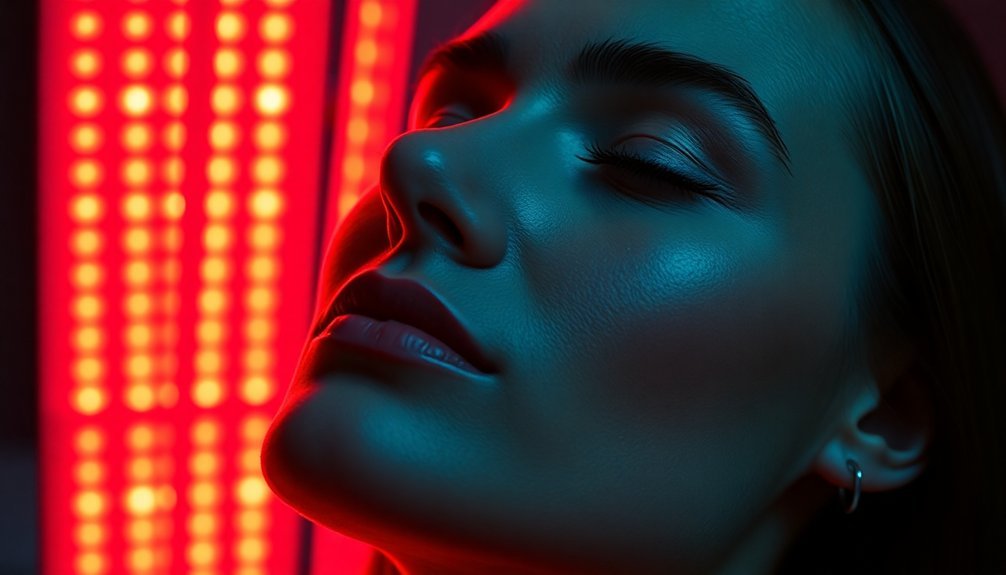



Leave a Reply